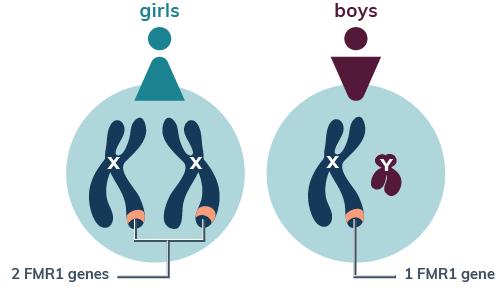Science Behind Fragile X

Fragile X runs in families
Fragile X can be passed down from one generation to the next.
- Nothing parents do before or during pregnancy causes fragile X syndrome or FXPM.
- It is not a contagious or communicable disease. It's genetic.
- It's complicated. Even within one family, people can be affected more mildly, more seriously, or not at all.
If you are curious about the cause of fragile X and how it runs in families, it helps to review information about chromosomes, genes, and how we pass on traits to our children.
What's a chromosome?
- In every part of our bodies--in blood, saliva (spit), skin, muscles, brain, and so on-- are tiny structures called chromosomes.
- Chromosomes are also in the mother's egg and father's sperm.
- One pair of chromosomes is called X and Y.
- Girls have two X's. Boys have an X and a Y.

What's a gene?
- On the chromosomes are thousands of genes. They are even smaller than chromosomes.
- Genes are like recipes for important chemicals in the body. They give the instructions that tell our bodies how to grow, develop, and function.
- There are many different forms of each gene. Different forms give slightly different instructions.

That's what makes us each unique!
How are traits passed down from parents to children?
- At the time a pregnancy is first made, half of the genes come from the mother's egg and half from the father's sperm.
- Genes bring instructions for family traits, passing them down from one generation to the next.
- Forms of genes that cause health or developmental issues can also be passed down from parents to children.
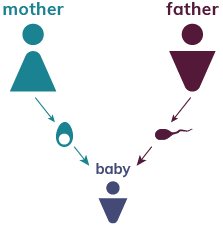
Genes that don't work can cause health problems
- Forms of genes that cause health problems are called mutations.
- A mutation keeps a gene from working properly, so that a needed instruction or chemical is not available to the body.
Remember that there is nothing parents do before or during pregnancy to make this happen.
Our brains need this important gene!
- One very important gene tells our bodies to make a chemical that's needed in the brain.
- Everyone has at least one copy of this gene.
- The formal name of the gene is FMR1. The brain chemical is called FMRP.
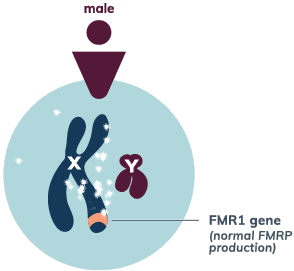
- The FMR1 gene is located at the end of the X chromosome.
- Girls have two X's, so they have two FMR1 genes.
- Boys have one X and one Y, so they have just one FMR1 gene.
What causes fragile X syndrome?
- People with fragile X syndrome have a mutation in the FMR1 gene that keeps it from working properly and stops the production of FMRP.
- The pre-mutation does not stop the production of FMRP.
- We often call FMR1 "the fragile X gene" because when this gene doesn't work, there is not enough FMPR in the brain.
- That's what causes fragile X syndrome.

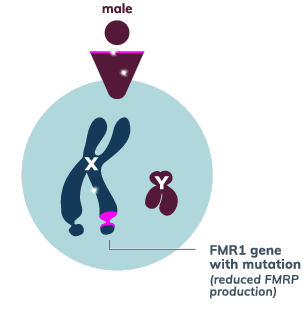
Why the name "fragile X"?
- The full mutation that causes fragile X syndrome makes the end of the X chromosome longer, so that it looks narrow or "fragile". This can only be seen with a microscope.
- That's where the name "fragile X" came from.

It's good to know that people with fragile X syndrome full mutation or FXPM are not physically weak or fragile.
Size matters.
- The fragile X test tells the size of the FMR1 "fragile X" gene(s).
- It's measured by counting a repeated pattern in the gene called a CGG repeat.
- More CGG repeats means a longer form of the gene.
- Long forms of the gene (full mutations) stop the gene from making FMRP--causing fragile X syndrome.
Most people have a smaller form of the gene, with less than 45 repeats and no mutation.
- FXPM usually has no health effects in childhood.
- Some adults with FXPM develop health issues. Learn more.
- Some women with FXPM have children with the full mutation that causes fragile X syndrome.
- The full mutation stops the gene from working and decreases the amount of the FMRP in the body and brain.
- All boys with the full mutation have fragile X syndrome.
- About than half of girls with the full mutation have fragile X syndrome, and features are usually milder.

Why is fragile X syndrome usually milder in girls?


- Girls with the full mutation tend to have fewer and milder features, and less than half have intellectual disability.
- Remember that unlike males who have just one copy of the gene, females have two copies.
- Even when one of their FMR1 genes has the full mutation, their other gene may still work normally.
- So females may have fewer or milder features of fragile X syndrome.
Where does the full mutation come from that causes fragile X syndrome?
For a woman with FXPM:
- Half of her eggs have the X chromosome with the normal FMR1 gene.
- Half have the X chromosome with FXPM.
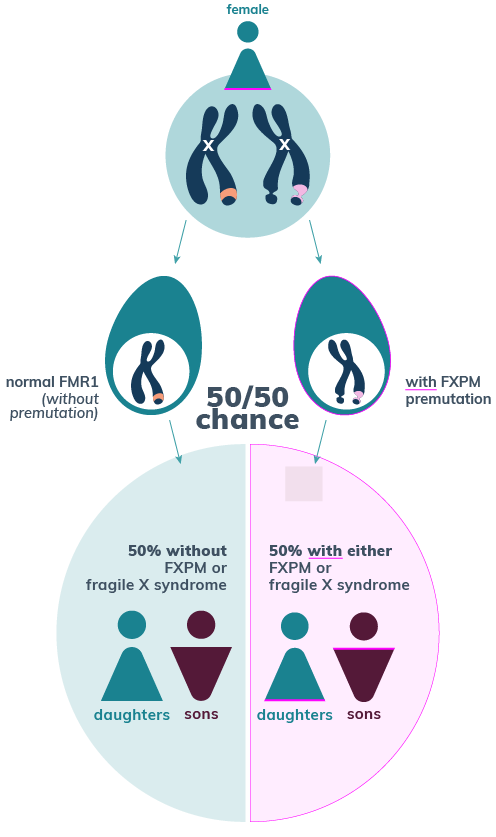
When does the gene expand?
Inside the eggs with FXPM, the number of CGG repeats often goes up and the gene expands. This happens before a new baby is formed.
It depends on her number of CGG repeats and on another factor in the gene called AGG interruptions, which can help keep the gene from expanding.
- In eggs with more than 100 CGG repeats, the gene always expands to the full mutation that causes fragile X syndrome.
- Boys with the full mutation always have fragile X syndrome. Girls have fewer and milder features.
- The Early Check fragile X test shows just the number of CGG repeats, but special labs also test AGG interruptions.
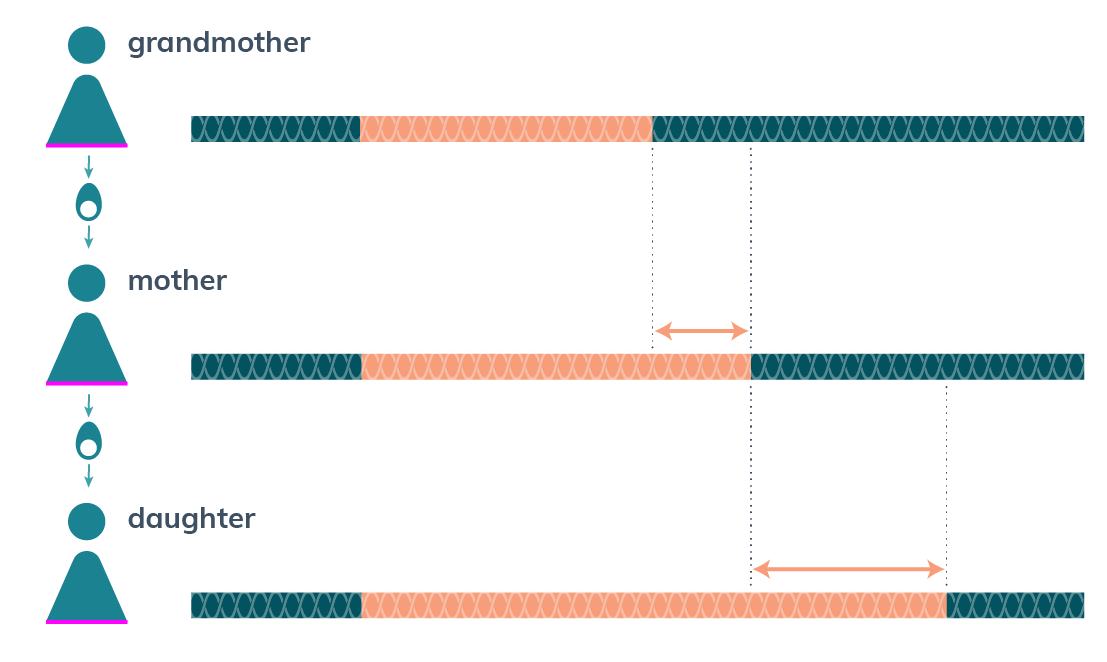
In this way, each generation tends to have more CGG repeats than the last, eventually resulting in the full mutation that causes fragile X syndrome.
Do men with FXPM have children with fragile X syndrome?
- Men with FXPM almost always pass it on to their daughters.
- The gene is more stable in sperm and almost never expands to become the full mutation that causes fragile X syndrome.

